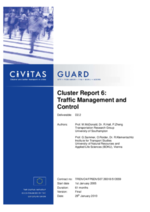Creating a clean urban transport area
Summary
The measure focused on the transformation of the city centre into a clean urban transport area, with positive impacts on transportation, the environment, and quality of life.
Implementing sustainable mobility
Prior to the CIVITAS TELLUS measure, Gdynia city centre was permanently congested. Private vehicles were parked on both sides of the city’s main street, and the heavy volume of traffic resulted in unacceptable levels of air pollution, as well as noise and vibration in nearby buildings. Congestion, along with the lack of infrastructure, were also barriers to the promotion of cycling among city residents for either commuting or leisure.
The measure was therefore aimed at making the main street, Swietojanska Street, more citizen and tourist friendly by reorganising traffic flow and parking places, introducing soft measures to discourage private vehicles, modernising the trolley-bus system, and improving the quality of public transport in general. The goals were to increase the number of pedestrians and cyclists in the city centre; increase the number of public transport passengers; and reduce congestion and air pollution.
Progress
The modernization of Swietojanska Street was divided into three stages in order to reduce inconvenience to businesses and residents. The consortium of companies responsible for the modernisation work was selected by public tender to fulfil a range of tasks financed by different sources. The renovation of infrastructure, the widening of pavements and the renewal of the street surface were financed by the local
authority. The installation traffic organisation elements, improvements to the trolley-bus infrastructure, the purchase and installation of bollards to prevent illegal parking and the installation of bicycle stands were carried out within the TELLUS project.
Outcomes
A total of 3,335 metres of new trolley-bus traction were installed on 136 traction pillars, eliminating noise and preventing the previously frequent disruption of traffic by the falling of trolley-bus belts. The number of passengers using the trolley-bus line crossing Swietojanska Street increased by 13.2 percent after the first stage of modernisation according to measurements and calculations carried out by the Public Transport Authority. The change was probably due to the smoother and quieter operation of the modern traction.
According to measurements and calculations carried out by external experts from the
Technical University in Gdansk the number of private vehicles visiting the clean city centre area decreased.
The installation of 961 bollards also prevented illegal parking that had previously hindered traffic flow. The reorganisation of parking places and improvements to public transport quality have contributed to reducing congestion: traffic flow fell from 662 vehicles per hour in 2000 to 601 vehicles per hour in 2003.
The wider pavements attract more pedestrians and have improved the situation of businesses in the area, with more people shopping and visiting restaurants and cafes.
This fact sheet has been updated by a third party on the basis of available information (not by the city itself), therefore we do not guarantee any data with respect to their content, completeness or up-to-dateness.









